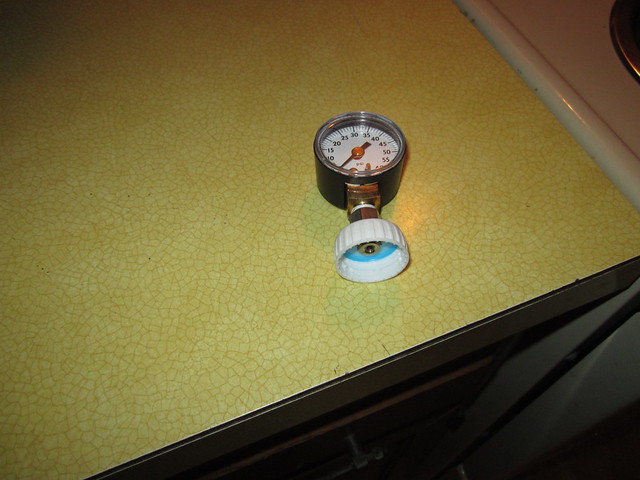Hey everybody, not wanting to double-post but I did a little experiment using a similar method described in another thread with cooler water (165 degree bath) with and without a preheat in tap water.
The original thread is:
https://www.homebrewtalk.com/showthread.php?p=7138735#post7138735
I thought it might be relevant to include here too, so here it is:
What brought this on: I did my first-ever batch pasteurization earlier today, a six bottle batch of ginger beer. To approximate the process Id be using in general, I set up four dummy bottles filled with water only and capped them. They all sat around with the ginger beer bottles to get to room temperature, put them through a pretreat as you mention here for 10 minutes in the hottest tap water I could get into the sink, then I treated all of them for ten minutes with a 175 degree starting bath temperature. After ten minutes I set all the bottles into an open-topped plastic tub to cool, but immediately popped the top on one of the WATER ONLY bottles and was surprised to find the internal temperature of the bottle was 166 degrees! This means that 175 degrees for ten minutes is MORE than enough to meet the 140 for 10 internal temperature rule. SO, I got to thinking about two things:
1.) Just how low can we go, temperature-wise, and still hit 140 degrees internal temperature for ten minutes;
And
2.) How much of a difference does the pre-warming in the sink really make?
My humble test methods:
-I started by preparing 20 standard 12-ounce longneck bottles with room-temperature (70 degrees) water, filled to about 1.5 from the top, and capped them all. I planned two batches:
-The first batch was the no prewarming batch, where I just took the room temperature bottles and put them right in the hot bath.
-The second batch was the prewarming batch, where I first treated the bottles to 10 minutes of the hottest water I could get from my tap.
Treatment details: I did the treatments in my Bayou Classic 10 gal pot that I use for boils. It measures 18 tall x 14 diameter. I placed a round cooling rack in the bottom of the pot to allow the hot water to get as much contact with the bottles as possible. The amount of water I used for the treatments was about 4.3 gallons, enough to get to about ½ below the caps when all ten bottles are submerged. Target temperature for both batches was 165 degrees; I was sure I could get the treatment temperature down a bit based on the earlier results from the 175 degree batch.
I DID use the lid on the pot.
I DID NOT continue to add heat through the treatment time, just flame off and bottles in.
I DID NOT insulate the pot, just let it cool. Insulating the pot would have yielded even better results, will have to consider that for future trials.
-Every five minutes, I removed one bottle, GENTLY inverted it a couple times to make sure the temperature in the bottle was consistent, popped the top, and measured the temperature of the water inside the bottle. I ran each treatment for twenty minutes, then removed all the bottles to my cooling tub. I then kept the clock running and continued to check temperatures in the bottles every five minutes to get an idea of how quickly they cooled. They cooled outdoors, in the mentioned tub; it was a windless 75 degree day.
Heres how things ended up:
WITHOUT PREWARMING
Time (minutes) Bottle internal temp. (degF) Bath temp. (degF)
0------------------------70----------------------163
5-----------------------131----------------------151
10----------------------138----------------------148
15----------------------140----------------------146
20----------------------140----------------------144
Remaining bottles were removed, and during the cool:
Cooling time (minutes) Bottle internal temp (degF)
5------------------------------133
10-----------------------------128
15-----------------------------124
20-----------------------------124
WITH PREWARMING
(The hottest water I could get from my tap was 130 degF. The prewarm cycle was a ten minute soak in water that was initially 130 degrees. Unlike the procedure used by the OP, I did NOT top off with fresh hot water as it cooled. After ten minutes, the internal temperature of one of the bottles was 103 degF. I immediately moved all ten into the treatment bath at that point.)
Time (minutes) Bottle internal temp. (degF) Bath temp. (deg F)
0----------------------103------------------------165
5----------------------141------------------------155
10---------------------147------------------------153
15---------------------148------------------------151
20---------------------147------------------------148
Remaining bottles were removed, and during the cool:
Cooling time (minutes) Bottle internal temp (degF)
5----------------------------140
10---------------------------134
15---------------------------132
20---------------------------126
(sorry about the crappy formatting on the numbers. I should have imbedded jpgs of the tables. Next time...)
My humble conclusions:
- Even without the prewarming, the lower 165 bath temperature still came very close to meeting the rules for 140 for 10 after only ten minutes in the bath. I know that 138 degrees isnt 140, but its definitely much higher than the 120 degrees that is considered yeast death temperature. Leaving the bottles in for 20 minutes would pretty much have satisfied the rule. But this would take longer to do a full batch, and since you can preheat the coming batch while the previous batch is cooking, its a good time-saver.
- With prewarming, the lower temperature of 165 degrees still knocks it out of the park. A bottle removed after ten minutes in the bath would be 147 degrees, would have been over 140 since the five minute mark, and would still be over 140 for the first five minutes of the cooling cycle, so youre good to go.
- There are SO many different directions you can take this. I was very surprised at how quickly the bottles reached equilibrium with the bath temperature. If you were worried about exploding bottles (due to higher carbonation levels or whatever) and wanted to experiment with even lower temperatures for longer soak times, have a go! Also, Id figure the lower the temperature seen by the beverage, the less effect on taste there would be (no?). Find a bath temperature and time interval that works for you!
- I really like the idea of treating a CLEARLY MARKED water-filled bottle at least once in a while to check your process and make sure youre hitting your targets. This way, you KNOW how hot your beverage is getting. Obviously, use your noggins kids: NO opening of carbonated bottles while theyre still hot, right!? The heat capacity of water is higher than that of ethanol, so if anything the temperature the mixture of water and alcohol in your drinkin bottles will be just a smidge higher than your water-only test bottle.
Holler if I missed any details in the procedure, I will address them.







![Craft A Brew - Safale S-04 Dry Yeast - Fermentis - English Ale Dry Yeast - For English and American Ales and Hard Apple Ciders - Ingredients for Home Brewing - Beer Making Supplies - [1 Pack]](https://m.media-amazon.com/images/I/41fVGNh6JfL._SL500_.jpg)















